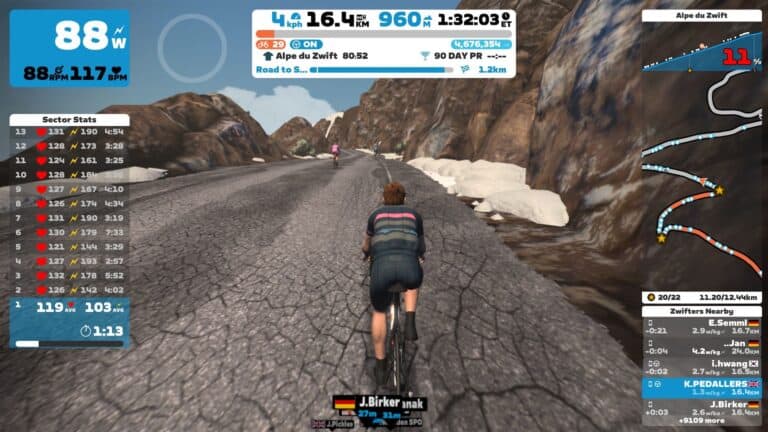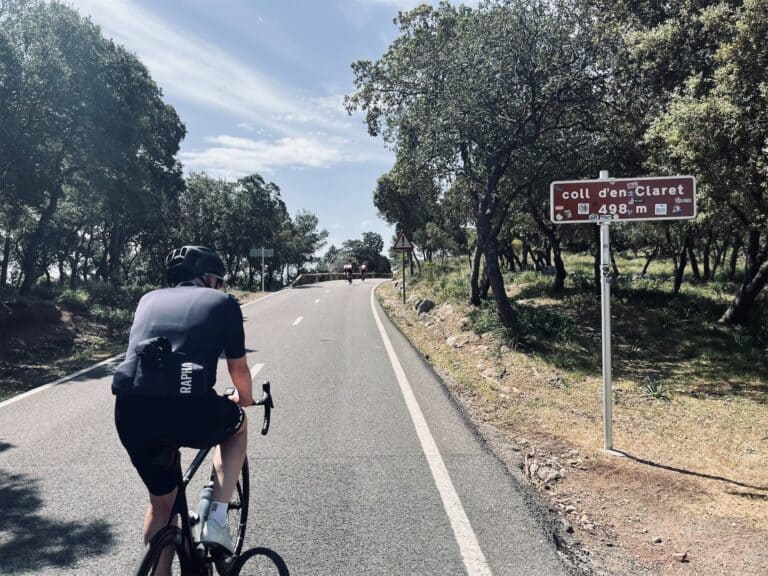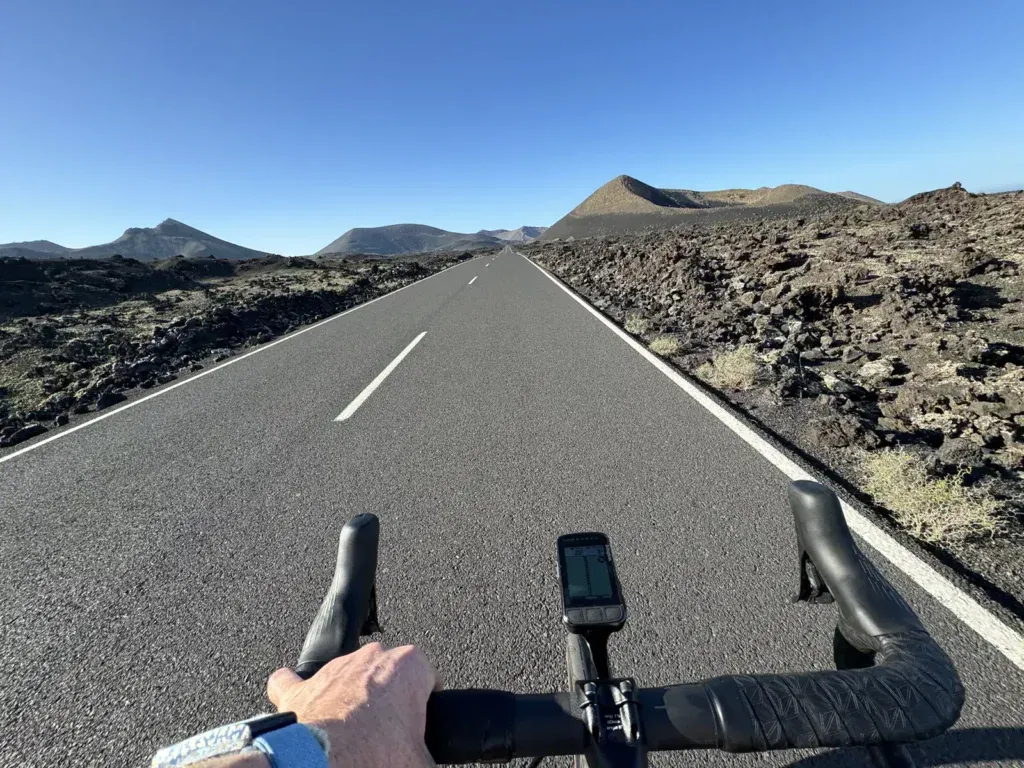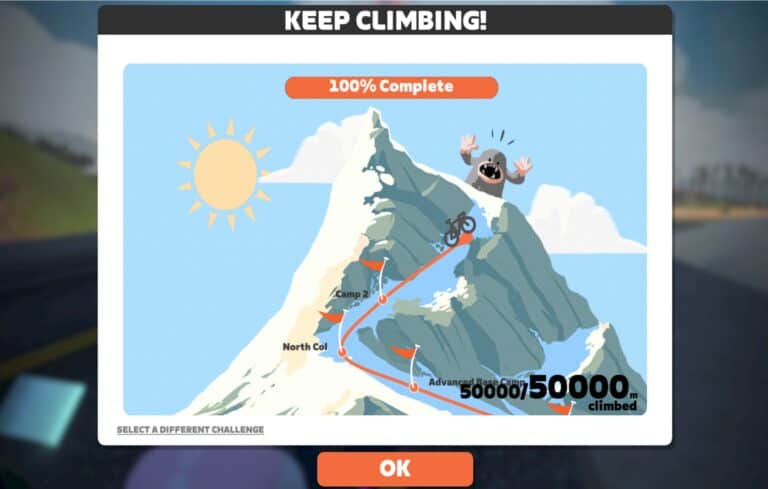Nothing gets you better at climbing like – climbing does, especially cycling hill repeats. Hill repeats help you gain strength, stamina, average speed, aerobic power, improved management of lactic acid, and grit.
When I can’t get outside, I practice hill repeats inside on my trainer. Zwift routes such as Sand and Sequoias or Alpe de Zwift give you time to warm up and climb. But you can do hill repeats in real life, too, to help increase your power and strength on the bike.
In this article, we’re going to talk about Hill Repeats. While some may see this as pure suffering on the bike, I see this as a great workout to get fitter, faster, and stronger.
We’ll look at some tips and techniques to help you get started with hill repeats, talk about how and how often to work on hill repeats, and give you some suggestions to get started. But first, let’s talk about how hill repeats are good for you.
Key Takeaways
- Hill repeats help you improve your climbing, strength, power, and stamina
- You can do hill repeats once or twice a week, depending on your training schedule
- If you’re struggling to get uphill, you may need some easier climbing gears to help
- Make sure you are fueling well when you climb
- Over time, you’ll get better and faster when you’re climbing
Hill Repeats Cycling (Are They Good?)
Hill repeats are a great way to improve your climbing abilities. Tough workouts like hill repeats can increase your aerobic capacity and stamina for tough rides. Hill repeats don’t just help your physical abilities – they help you improve your mental toughness.
So you won’t be as stressed mentally when you’re out on a tough ride.
Hill repeats also help your body to manage lactic acid better and produce more threshold power. In addition, you’ll improve your strength and muscle tone because uphill riding works your glutes and quads.
You may also improve your ability to ride out of the saddle, which can increase your sprint power. But you can’t just do one hill workout and expect life-changing results – you need to make hill repeats a regular part of your workout schedule.
Main Benefits of Doing Hill Repeats Cycling
Hill repeats are a popular form of training for cyclists who want to improve their climbing ability and overall fitness. Here are some of the main benefits of doing hill repeats:
- Improved muscular endurance: Hill repeats force your leg muscles to work harder than they would on flat terrain, helping to improve your muscular endurance and make you a stronger rider.
- Increased cardiovascular fitness: Cycling uphill at a high intensity requires your heart and lungs to work harder to deliver oxygen to your muscles. Over time, this can help to increase your cardiovascular fitness.
- Enhanced power output: By focusing on climbing hills, you can train your body to produce more power when cycling uphill, which can translate into improved performance on other types of terrain.
- Mental toughness: Hill repeats can be physically challenging and mentally demanding, which can help you develop mental toughness and resilience that can be useful in other areas of your life.
- Time-efficient training: Hill repeats can be a time-efficient way to get a high-quality workout in a relatively short time. You can often get a great workout in just 30-60 minutes, depending on the length and steepness of the hill.
How Often Should You Do Hill Repeats?
I had great results when I incorporated a trip up Alpe de Zwift once a week. Of course, my weekly results varied a lot – some weeks, I was faster, and some weeks I was slower. But the cumulative results of doing a long, hard climb each week meant big gains in my IRL climbing power.
You can do hill repeats once or twice a week, depending on the rest of your workout schedule. They need to be hard and frequent enough to create enough stress to cause muscle adaptation but not so much that the fatigue destroys the rest of your workouts and rides.

Cycling Hill Repeats Training (Getting Started)
Not sure how to climb? Here are some tips to help you get started.
Choose the Right Gears
Using the right gear ratios is critical to your climbing success. If you have a hard time getting up the climbs, consider getting some easier gearing. This way, you can spin your way up at a higher cadence, which puts less strain on the legs.
In my experience, switching to an 11-34 cassette has been a revelation; it provides a wide enough range to allow for a comfortable spin up steep inclines or to apply more power when needed.
This cassette size has become my go-to, ensuring I’m equipped to tackle any climb without resorting to the strain of grinding gears (and knees) – and for me, it’s Shimano all the way, as it’s consistently outperformed SRAM in my setups.
Lighten Up
Climbing speeds are generally slower, so you won’t be drafting. When fighting against gravity, your power-to-weight ratio is more important than riding on the flats. So to climb faster, you need more power and less weight.
Of course, you could try to shed a few pounds if that’s appropriate for you and your health. But you could also shed a few pounds off your bike. For example, you might leave the heavy saddlebag and tools at the bottom of the hill.
They’ll be nearby if you need them, but they won’t be weighing down your bike as you climb. Of course, if you’re serious about dropping some grams for climbing, you could go with a lighter bike, wheels, shoes, and helmet.
When tackling hill repeats, your helmet should never be a distraction. That’s why I swear by the Kask Mojito3 for its outstanding comfort and easy adjustability. It’s my go-to helmet, outshining others for a focused and safe training session.

But for most of us, just keeping the same bike setup for hill climbs will help us reap more benefits as we push a little extra weight up the climb.
Pace Yourself
One of my biggest challenges with climbing is pacing myself. I want to get up over that hill and do it fast! But faster isn’t always better. When I start out too hard, I sometimes blow up my heart rate part way up the climb and end up having to slow down and recover anyway.
Climbing well is as much about pacing as it is about gear and power. If you go out too hard, you’ll pop and run out of energy to finish your workout.
If you’re new to climbing, err on the side of keeping things under control: try to keep your heart rate low, your power low, and your cadence high.
It’s ok to climb slowly, especially at first. You’ll get faster the more you practice hill climbing.
As you get towards the end of the climb, you can increase your power and pace if you have more energy. Over time, you’ll learn what a good pace is for you, and then you can start to push it more and more as you get better and better at climbing.

Fuel Right
As the saying goes, you can pour from an empty cup and can’t climb on an empty fuel tank. So start with a good breakfast – maybe some low-fiber carbohydrates to help you top up your glycogen stores without weighing you down.
Bread, white rice and eggs, or other low-fiber foods can give you energy without feeling heavy in your stomach.
Before I tackle a challenging climb, I always take an energy gel around 15 minutes beforehand to aid sustaining my effort — else i fear I’ll hit the wall or bonk. Try reaching for something like a GU Energy Gel for that quick and convenient carbohydrate surge.
They’re crafted for a swift energy release, which is crucial for fuelling my climb and keeping my performance level up during those intense pushes. Fuelling right is a small thing that can have a big impact on a ride.
Use the Right Technique
There are a number of techniques you can employ to become a better climber. But first, work on your mental game.
When I climb a new hill, I always get nervous that I won’t make it over. My nerves turn to stress, which makes me push too hard, too soon. But when climbing a familiar hill, my mind and body remember that I’ve done this before! I know exactly what to do, so it helps me relax.
Use your Bike Computer
Karoo, Garmin, and other cycling computers have climbing functions to help you pace your climb well. For example, you can usually see a representation of the hill you’re on, so you can see where to push hard, where to recover, and when to take it easy.
On one particularly steep climb, I’ve had to grind up so slowly that my old bike computer would auto-pause, thinking I’d stopped, and skip recording that segment.
But with the Wahoo ELEMNT BOLT and its speed sensor bundle, this is no longer a problem. It keeps tracking accurately, no matter how tough the climb, allowing me to focus on maintaining a consistent output and reaching the top without blowing up.

Should You Sit or Stand?
I like to sit on a climb for as long as possible. Seated climbs are definitely more efficient, especially on shallower gradients. Standing gives you a heart rate penalty – that is, when you stand to pedal, it uses more muscles, which increases your heart rate.
However, once you hit steeper hills, over 10 percent, standing up will let you use more power to get over the climb. Even better if you can practice climbing both ways!
If you need more help with your climbing technique to prepare for hill repeats, check out this video by Charles Ouimet. He learned new climbing techniques when he spent a week at EF’s training camp.
Cycling Hill Repeats Workout (Step-By-Step)
My first experience with hill repeats was challenging, and I only made it up that hill once while others were practicing for an Everesting challenge. The next time, I did it twice. Now that I’m stronger and fitter, I could do that same hill several times in a row. Here’s how to get started.
Basic Hill Repeats
- Find a hill that takes several minutes to climb. If you’re new to hill repeats, it could be a shallow hill or a series of rollers. Again, you want it to be a tough workout but not completely demoralizing.
- Do a 15 to 20-minute warm-up, including some easy spinning and 3 or 4 30-second bursts to increase your heart rate.
- Start climbing! Remember to start at an easier pace than you might expect. You can always increase your pace as you get to the top.
- Use the descent for recovery.
- Repeat! Over time, you’ll find the right pace that you can sustain for an extended climb but doesn’t overtax you.
Uphill Sprints
Uphill sprints are a great way to start if you want to increase your explosive power. My track coach gave me some uphill sprints to work on, and they go something like this:
- Find a hill that will take you ten minutes or more to climb at an easy pace.
- Do a good 15 to 20-minute warmup.
- Climb for 2 or 3 minutes – at a relaxed pace.
- Sprint hard for 20 seconds.
- Go back to climbing at a relaxed pace to recover.
- Repeat until you reach the top of the climb.
Over time, you can increase your Rate of Perceived Exertion from your easy pace to an RPE of 7 to 8.
Everesting Challenge
If you really want to get good at hill climbing, you might try training for an everesting attempt. Everesting is when you cycle the elevation of Mt. Everest in a single attempt. Depending on your fitness level, it could take you 20 to 25 hours, although the women’s record is only 9!
An Everesting training plan requires a lot of hill climbs and a lot of elevation. However, you can find some ideas – and a serious training plan – here.

Final Thoughts on Hill Repeats
Hill repeats are a great way to increase your power and strength for cycling and increase your ability to climb. These are tough workouts, but they don’t have to be stressful.
Find a hill you are comfortable with and set up a ride with friends. You can each climb at your own pace, but you’ll have fun passing each other up and down or taking rest stops together. The companionship can make a hard workout a lot more fun!
If you’ve never done hill repeats before, gather some friends and give it a go! Let us know in the comments how it went and what you would do better next time.
FAQ
Are hill repeats good for cycling?
Hill repeats are great for increasing your cycling power, strength, and grit.
How often should you do hill repeats cycling?
Depending on your goals and training schedule, you can do hill repeat workouts once or twice weekly.
How many hill reps should I do cycling?
The number of hill reps depends on your fitness level. You might only be able to do one when you’re first starting. That’s ok – keep trying, and maybe you can do one and a half or even two next time.
How long should you do hill repeats?
You’ll need a good 15-minute warm-up and a 15-minute cool-down. After that, you can do 30 to 60 minutes of hill repeats in between for a good, tough workout.
Why do I struggle cycling uphill?
Cycling uphill takes more strength and energy as you fight gravity. Of course, the bigger you are, the harder it is to hill climb. The steeper the hill and the more elevation per ride, the harder it is. But with practice, those hills will get easier!
How can I cycle uphill without getting tired?
Climbing is hard work! If you get too tired riding uphill, you might need easier gears. You can also work on your strength and fitness to help you feel better when climbing.
